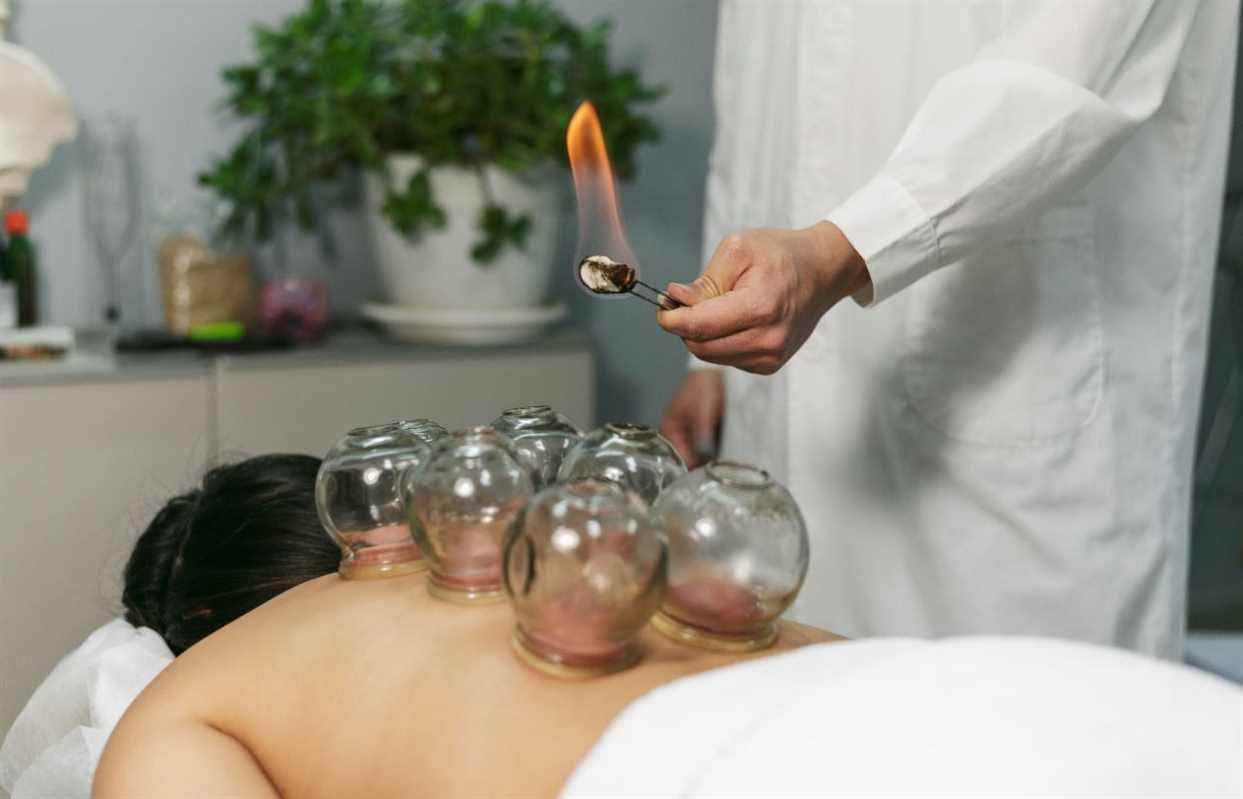A healthcare professional may have already put suction cups on you, those funny glass or plastic objects shaped like bells that leave purplish marks for days on end.
Or you may have heard people (often elderly) say that cupping therapy is nothing new!
Cupping therapy is a medicine in its own right and can be a real tool used during a session with your osteopath.
But how does it work and can we use it on all types of pathologies?
Types of suction cups and principle
There are most often three types of suction cups. Hot laying (which is the oldest method and one of the most used) where we insert a cotton ball soaked in rubbing alcohol and ignited in the suction cup, cold laying (which is more practical because it only requires a gun that can suck the tissues) and finally scarified suction cups which require a small scratching of the treated area (method reserved for experienced practitioners).

Hot application of suction cups
https://acupuncturemaca.ca/acupuncture-rive-sud-montreal/ventouses-cupping
The principle of the suction cups is simple and consists in creating an effect of depression inside the container, this vacuum created makes it possible to “suck” the patient’s skin inside the suction cup has multiple effects which we will detail below. .
Actions of suction cups on the body
As Daniel Henry, osteopath and physiotherapist who pioneered the use of suction cups in France, says ” cupping medicine allows, among other things, to treat areas so knotted that the application of the hands would require several sessions, at best. “
Once the suction cup is installed, it has different actions on different planes of our body.
The first is mechanical action because it allows to play on the elasticity and the flexibility of the underlying tissue, whether on the cutaneous or muscular and tendon planes. It makes it possible to “take off” the tissue, to soften it thus to give again mobility to it and also to encourage the arrival of anti-inflammatory cells of the organism.

Cold installation of suction cups
https://www.alternativesante.fr/medecine-chinoise/les-vertus-des-ventouses
Significant vascular action is also observed. Cupping causes local hyperemia which is a pool of blood in an area. It is this hyperemia that gives this purplish red appearance which occurs during installation and often persists when the suction cup has been removed (this mark disappears after 5 to 7 days).
In his book “Therapeutic Guide in Cupping Medicine”, Daniel Henry tells us that “this mechanism locally causes the stasis and underlying tissue collections to move towards the surface of the skin. », They therefore cause deep vasoconstriction and surface vasodilation.
The suction cups also make it possible, on a respiratory level, to improve the circulation of alveolar oxygen and participate in the detachment of bronchial secretions..
Consult a Certified Osteopath
Use and efficiency of suction cups
The first indications for therapeutic suction cups are osteo-articular, ligament and tendon disorders such as low back pain, neck pain, shoulder pathologies, tendonitis, ankle sprains, etc. Via the analgesic action described above, the placement of a suction cup may lead to a reduction in pain and local inflammation often associated with this type of disorder.
But suction cups can also be used for digestive and gynecological pathologies (premenstrual syndrome, constipation, etc.), in pneumology (asthma, bronchitis, etc.), for migraine or headache problems and even for psychological disorders (depression, chronic fatigue, etc.) ). In these areas, the practitioner will use knowledge in Traditional Chinese Medicine to practice energy rebalancing and / or decongestion of the suffering area.
Pain, as a rule, remains the most important reason for the use of therapeutic suction cups.. A systematic review of the existing data on the effectiveness of cupping therapy to treat pain was even published in 2011, proof that more and more patients are turning to this medicine to reduce their pain.

Treatment protocol for decongestion of the spleen / stomach sphere
Book “Therapeutic guide in suction cup medicine” Daniel henry
The field of application of cupping medicine is very wide and their installation requires real reasoning resulting in a construction that goes beyond simply placing a suction cup on a painful area. I remind you that any installation will be done after a check-up and a clinical examination carried out by a medical professional.
And osteopathy in all of this?
More and more osteopaths are being trained in the installation of therapeutic suction cups, they are a relevant tool that complements the osteopathy session. They can also be the subject of an entire session. They can be used before or after osteopathic treatment to reduce inflammation if there is any, increase tissue elasticity so that your osteopath’s manipulations can be more efficient and last over time. or as a supplement for patients suffering from more complex disorders.
Consult a Certified Osteopath
